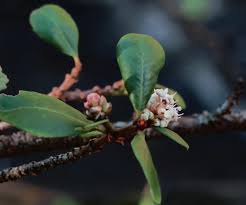In January 2021, the California Department of Food and Agriculture announced the pest rating for Phytophthora occultans, one of two species of Phytophthora it was reviewing. (Once at the website, click on “comment” – next to name Heather Sheck.)
I blogged about this action in December.
Five people or organizations submitted comments. The most comprehensive comments were submitted by Elizabeth Bernhardt, Ph. D. and Tedmund Swiecki Ph.D. of Phytosphere Research. Another scientist was Tyler Bourret, who had been the first to detect P. occultans in California when working as a student in 2015-16. The third scientist was Jennifer Parke, a plant pathologist at Oregon State University who has worked with Phytophthora species in agriculture and wildland settings for 36 years. Additional comments were submitted by the Phytophthoras in Native Habitats Work Group and me.
All commenters raised some issues. First was the lack of information on the true distribution of P. occultans in California. CDFA restated that it that relies on official records and survey information, and that those records support a “low” rating.
Several issues relate to the definitions that CDFA applies in assigning ranks. They are so restrictive that – in my view – they result in underestimates of pathogens’ potential impacts.
One example is how CDFA recognizes first detections of a pathogen. As Bernhardt and Swiecki point out, CDFA’s consideration of only “official” samples prevents timely action to protect California’s agriculture and native vegetation. In the case of P. occultans, CDFA took no action for two years after the pathogen was first reported in the state. This detection had been confirmed by a CDFA laboratory.
A second example is host range. CDFA says it assigns a host range rating of “wide” (rating of “3”) only to pathogens that have host ranges of hundreds of species. This means that pathogens with dozens of known hosts across several plant families are given a ranking of “moderate” (2). Furthermore, the agency considers only “official” samples in defining hosts. This approach precludes consideration of the high probability that additional hosts would be found in future, including federally listed species in the genera Ceanothus and Arctostaphylos. Bernhardt and Swiecki named two additional hosts based on field work. CDFA responded to the second point by adding a reference to the likely expansion of the host range in the “Uncertainty” section of the document.
Similarly, CDFA gives a reproductive potential rating of “3” only to pathogens spread by a vector or that infect seeds.
CDFA staffers who manage specific pests lack authority to change these too stringent ranking criteria. The agency leadership need to adopt more realistic criteria.
CDFA responded by accepting many of the additional factors raised primarily by Bernhardt and Swiecki. This resulted in raising the overall score from 11 to 14, and changing the ranking from “C” to “B”.
Posted by Faith Campbell
We welcome comments that supplement or correct factual information, suggest new approaches, or promote thoughtful consideration. We post comments that disagree with us — but not those we judge to be not civil or inflammatory.
For a detailed discussion of the policies and practices that have allowed these pests to enter and spread – and that do not promote effective restoration strategies – review the Fading Forests report at http://treeimprovement.utk.edu/FadingForests.htm
